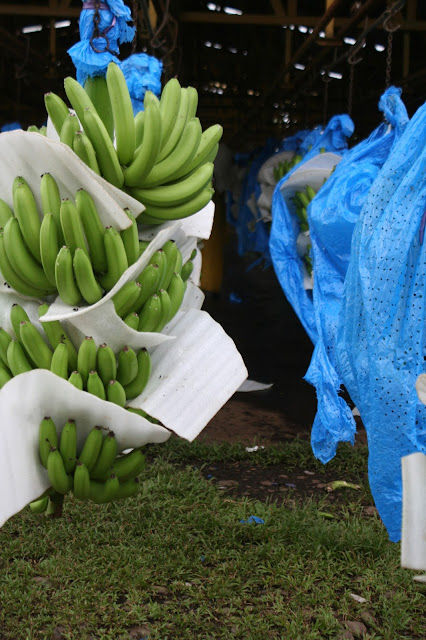After spending the day at Earth University on our second day, we stayed at the La Quinta Sarapiquí Inn (not related to the La Quinta chain of hotels in the US!).

During breakfast the next morning, there were several colorful birds and a green basilisk lizard eating bugs on the roof across the way. It is very colorful! I also saw the related brown color Jesus Christ down by the pond that I walked to on the grounds.


He would stick his head in between the tiles, presumably looking for insects to eat!

A female green honeycreeper.

I believe that this is the male green honeycreeper along with an unidentified brown bird. The greenish color of the make and female is different which is weird... Actually that blue one is maybe a different species of bird...

In not quite sure what that blue bird is doing to the brown bird's behind! Ha ha! Just kidding - awkward photo angle, I think. If I'm identifying them right, the right is the female green honeyvcreeper

Two blue-gray tanagers.

These Passerini's tanagers were common.

Breakfast at La Quinta - a typical Costa Rican breakfast includes gallo pinto (black beans and rice), eggs, plantains, and fresh fruit.

A cool red flower at the hotel grounds.

The third morning, we went to the Organization for Tropical Studies (OTS)'s La Selva Biological Reserve, which is one of the most well-known rainforest research centers in the world. I read about it during my college days! We climbed a 41meter high tower! There was one tower that went to 30 something meters, followed by this bridge across to another one, which went another 10 m. It was awesome. We were atop the canopy! Researchers use it to study various aspects of the rainforest canopy world. We just clamped in and had the gorgeous headgear for safety.

This is a view of another canopy across the way from the one we climbed.

We saw a sloth right outside the La Selva office/headquarters/cafeteria. This is a terrible picture, but it's the best I got! I got better sloth photos last trip.

While at La Selva, we saw a troop of black-faced howler monkeys, including a mom with a baby! Not while we were in the canopy, but we did hear them up there. Again not a good photo at all, but it's all I could get!

This is the blue jean frog, a species of poison dart frog that is about 1 cm long! Tiny! We saw it on a hike through the jungle at the Organization for Tropical Studies' La Selva Biological Station.

We also saw a green and black poison dart frog. They are bigger than the blue jeans frog (which is only about 1cm long!)

We saw these adorable Honduran white bats (tent making bats) under a huge leaf at La Selva.

This is the Sarapiqui River we crossed on a reallllly long suspension bridge to get to the cacao plantation at Tirimbina Reserve.

A cacao tree. For some reason the trunks arch! That's how you can tell them apart from other trees. Also the cacao fruit grows right out of the trunk! That trait is known as cauliflory.

As we walked across the long suspension bridge at Tirimbina, these iguanas were visible in the tree over the river. Massive tree iguanas: Whoduthunk it?

And a hint of what is to come next... this is a most beautiful sunset at Playa Grande on our second to last evening. This is the magical place where I had a most memorable two weeks in 1999 reporting on leatherback sea turtle nesting for Discovery Channel. Check out the archived Love & Death on Turtle Beach.






















































